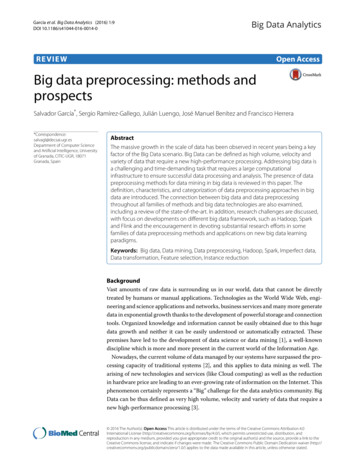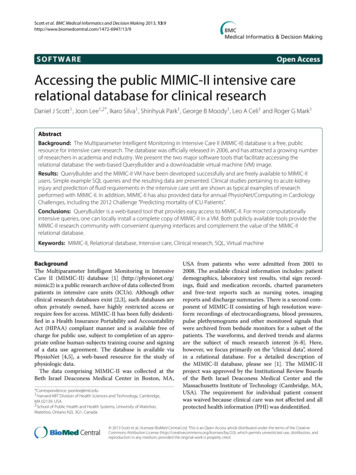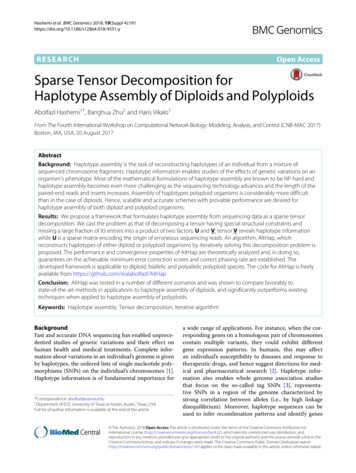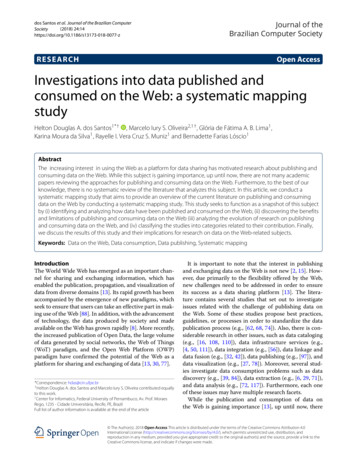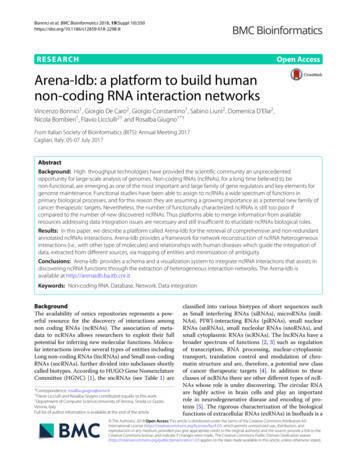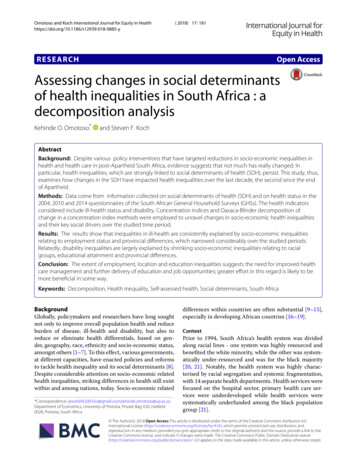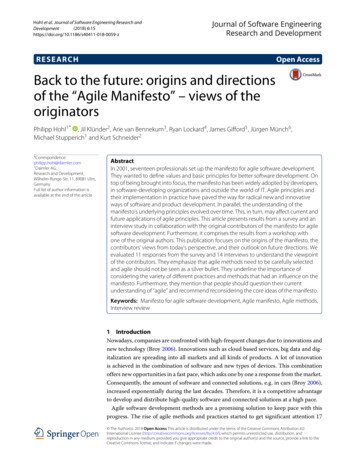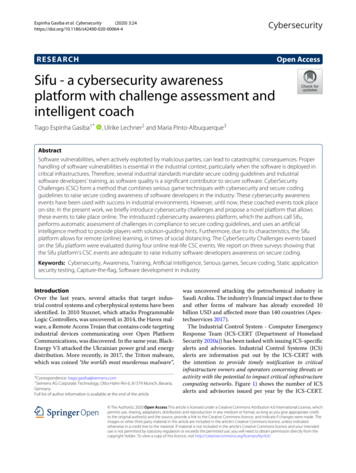
Transcription
Cybersecurity(2020) 3:24Espinha Gasiba et al. 064-4RESEARCHOpen AccessSifu - a cybersecurity awarenessplatform with challenge assessment andintelligent coachTiago Espinha Gasiba1*, Ulrike Lechner2 and Maria Pinto-Albuquerque3AbstractSoftware vulnerabilities, when actively exploited by malicious parties, can lead to catastrophic consequences. Properhandling of software vulnerabilities is essential in the industrial context, particularly when the software is deployed incritical infrastructures. Therefore, several industrial standards mandate secure coding guidelines and industrialsoftware developers’ training, as software quality is a significant contributor to secure software. CyberSecurityChallenges (CSC) form a method that combines serious game techniques with cybersecurity and secure codingguidelines to raise secure coding awareness of software developers in the industry. These cybersecurity awarenessevents have been used with success in industrial environments. However, until now, these coached events took placeon-site. In the present work, we briefly introduce cybersecurity challenges and propose a novel platform that allowsthese events to take place online. The introduced cybersecurity awareness platform, which the authors call Sifu,performs automatic assessment of challenges in compliance to secure coding guidelines, and uses an artificialintelligence method to provide players with solution-guiding hints. Furthermore, due to its characteristics, the Sifuplatform allows for remote (online) learning, in times of social distancing. The CyberSecurity Challenges events basedon the Sifu platform were evaluated during four online real-life CSC events. We report on three surveys showing thatthe Sifu platform’s CSC events are adequate to raise industry software developers awareness on secure coding.Keywords: Cybersecurity, Awareness, Training, Artificial intelligence, Serious games, Secure coding, Static applicationsecurity testing, Capture-the-flag, Software development in industryIntroductionOver the last years, several attacks that target industrial control systems and cyberphysical systems have beenidentified. In 2010 Stuxnet, which attacks ProgrammableLogic Controllers, was uncovered; in 2014, the Havex malware, a Remote Access Trojan that contains code targetingindustrial devices communicating over Open PlatformCommunications, was discovered. In the same year, BlackEnergy V3 attacked the Ukrainian power grid and energydistribution. More recently, in 2017, the Triton malware,which was coined “the world’s most murderous malware”,*Correspondence: tiago.gasiba@siemens.comSiemens AG Corporate Technology, Otto-Hahn-Rin 6, 81379 Munich, Bavaria,GermanyFull list of author information is available at the end of the article1was uncovered attacking the petrochemical industry inSaudi Arabia. The industry’s financial impact due to theseand other forms of malware has already exceeded 10billion USD and affected more than 140 countries (Apextechservices 2017).The Industrial Control System - Computer EmergencyResponse Team (ICS-CERT (Department of HomelandSecurity 2020a)) has been tasked with issuing ICS-specificalerts and advisories. Industrial Control Systems (ICS)alerts are information put out by the ICS-CERT withthe intention to provide timely notification to criticalinfrastructure owners and operators concerning threats oractivity with the potential to impact critical infrastructurecomputing networks. Figure 1) shows the number of ICSalerts and advisories issued per year by the ICS-CERT. The Author(s). 2020 Open Access This article is licensed under a Creative Commons Attribution 4.0 International License, whichpermits use, sharing, adaptation, distribution and reproduction in any medium or format, as long as you give appropriate creditto the original author(s) and the source, provide a link to the Creative Commons licence, and indicate if changes were made. Theimages or other third party material in this article are included in the article’s Creative Commons licence, unless indicatedotherwise in a credit line to the material. If material is not included in the article’s Creative Commons licence and your intendeduse is not permitted by statutory regulation or exceeds the permitted use, you will need to obtain permission directly from thecopyright holder. To view a copy of this licence, visit http://creativecommons.org/licenses/by/4.0/.
Espinha Gasiba et al. Cybersecurity(2020) 3:24Page 2 of 23Fig. 1 ICS-CERTOver the last decade, the number of security advisoriesissued per year has been steadily growing. Before 2014less than 100 advisories per year have been issued, whilefrom 2017 to 2019 more than 200 advisories per yearhave been issued. These numbers of security advisoriescorrelate well with the observed increase in the numberand sophistication of cyber-attacks to industrial controlsystems.According to an estimation by the United States Department of Homeland Security (DHS), about 90% of thereported security incidents result from exploits againstdefects in the design or code of software (Department ofHomeland Security 2020b). Related to this, a recent largescale study by Patel el al. 2020 has shown that more than50% of software developers cannot spot vulnerabilities insource code (Schneier 2020). These two factors considered together mean that: 1) special care must be exercised during software development, software developers,and 2) software developers lack awareness about securecoding.Exploitation of low quality software can result in severeconsequences for both customers, companies that produce the software (or product), and even unrelated thirdparties. The negative consequences are especially acutewhen the vulnerable software is deployed in critical infrastructures. In this scenario, the negative consequences canrange from monetary losses to loss-of-life.The work present aims to improve the current situation utilizing a serious game -that we coined CyberSecurity Challenges (CSC)- designed to raise awarenesson secure coding, secure coding guidelines, and softwaredevelopment best practices of software developers in theindustry. This work also presents the Sifu platform, asoftware tool developed to implement the CSC seriousgame.Addressing code defects during software developmentAccording to Mead et al. (2004), addressing securityvulnerabilities in source code early in the softwaredevelopment life-cycle can save many costs. Their workpresents an empirical model that shows the incurredcosts of fixing software vulnerabilities at the followingphases: requirements engineering, architecture, design,implementation, testing, deployment, and operations.The validity of this model is corroborated by Black (2004),which describes how addressing software defects early inthe software development stages (in particular, by earlyinvolvement of the software testing team) can also lead tocost savings.In an industrial setting, due to the requirementsimposed by standards (e.g. ISO27k 2013, IEC 62443 2018,PCI/DSS 2015, BSI5.21 2014), the requirements engineering, architecture and design phases are typically well covered. The compliance to these standards is checked duringindustry audits. Recent data (Department of HomelandSecurity 2020b; Patel 2020), however, suggests that software defects (and vulnerabilities) are being introducedwhen the software is being developed - by software developers - in the implementation stage. In this early softwaredevelopment stage, we would like to address the softwareimplementation stage in our work.One possible method that can be used to reduce thenumber of introduced software vulnerabilities is StaticApplication Security Testing Tools (SAST) at the softwareimplementation stage. However, these have been shown tonot perform well in detecting security vulnerabilities in thesource code (Goseva-Popstojanova and Perhinschi 2015),and consequently, additional mechanisms must be used.In our work, we concentrate on the human factor, the software developer, since the software developer ultimatelywrites the software by hand.
Espinha Gasiba et al. Cybersecurity(2020) 3:24For the implementation, there is a vast number of possible programming languages. We have decided to focusour work on the C and C programming languages.Our motivation to choose this programming language istwofold: 1) because this programming language is beingactively (and highly) used in the industry where the firstauthor works as a consultant and 2) a recent study byWhiteSource (2019) shown that C and C are amongthe most vulnerable programming languages in terms ofcybersecurity vulnerabilities.Industrial standards and guidelinesIn recognition of the importance of secure products anda consequence of the current move towards digitalizationand higher connectivity, several large industrial playershave joined together and committed to a document calledthe charter of trust (Siemens 2020). The Charter of Trustoutlines ten fundamental principles that the partners vowto obey to address the issues inherent with cybersecurity. ICS relevant standards such as IEC 62443-4-1 2018 orISO 27001 2013 mandate not only the implementation ofsecure software development life-cycle processes but alsoawareness training.These standards (IEC 62.443 and ISO 27k) address security from a high-level perspective and are not specificenough about recommendations and policies to be followed in software development. Towards this goal, anindustry-led effort was created, the Software AssuranceForum for Excellence in Code (SAFECode 2018), with theaim of identifying and promoting best practices for developing and delivering more secure and reliable software,hardware, and services.In terms of the programming languages C and C , dueto its popularity in the industry, there exist several securecoding standards. Carnegie Mellon provides a popularsecure coding standard - the SEI CERT Secure CodingStandard (Carnegie Mellon University 2019), which aimsat safety, reliability, and security of software systems. Otherpopular (secure) coding standards include AUTOSAR2017 for the automotive industry and the MISRA codingstandard (Misra 2012; 2012) for embedded devices.Another reason to focus on the software developer isthat these standards contain undecidable rules, i.e., rulesthat cannot be automatically checked by an automaton(Kässtner et al. 2020). In this case, it requires humanintervention to understand the software and decide theappropriate measure. This intervention is possible if thesoftware developer is aware and knows the appropriatesecure coding guidelines.Serious gamesA serious game (Dörner et al. 2016) is a game that isdesigned with a primary goal and purpose other thanpure entertainment. Typically these games are developedPage 3 of 23to address a specific need such as learning or improving a given skill. Serious games are a well-establishedinstrument in information security. They are discussedin de-facto standards as in the German Federal Officefor Information Security - IT Baseline Protection (BSIGrundschutzkatalog) (Bundesamt für Sicherheit in derInformationstechnik 2019; Bundesamt für Sicherheit inder Informationstechnik 2020) as a mean to raise ITsecurity awareness and increase the overall level of ITsecurity.A Capture-the-Flag (CTF) game is one possible instanceof a serious game. CTF games were initially developed inthe penetration testing community and are mostly used bypentesters, security professionals, academics, and hobbyists to improve their offensive skills. Votipka et al. 2018bargue in their work that CTF events can also be used asa means to improve security software development. Inparticular, they show that the participants to such eventsexperience positive effects in improving their securitymindset (i.e., defensive mindset). Davis et al., in 2014a,also discuss the benefits of CTF for software developers,and they argue that CTFs can be used to teach computer security and conclude that playing CTFs is a fun andengaging activity.Playing cybersecurity (serious) games is gaining moreand more attention in the research community (Rieb 2018;Rieb et al. 2017). In Frey et al. (2019), show both thepotential impact of playing cybersecurity games on theparticipants and the importance of playing games as ameans of cybersecurity awareness. They conclude thatcybersecurity games can be useful to build a commonunderstanding of security issues.In their work, Simões et. al 2020 present several programming exercises for teaching software programmingin academia. Their design includes nine exercises thatcan be presented to students to foster student motivationand engagement in academic classes and increase learning outcomes. Their approach uses gamification and toolsto perform automatic assessment of submitted solutionsto exercises. However, their work focus on the correct(functional) solution of the programming exercise andnot on secure programming and security best practicesaspects.In a closer approach to a solution suitable to theindustry, Gasiba et al., in 2019 perform requirementselicitation employing systematic literature review, interview of security experts, and elicit requirements fromCTF participants and games performed in the industry. Their work focuses on identifying the requirements necessary for serious games events based on CTFto raise secure coding awareness of software developers in the industry. The newly derived type of eventis called the CyberSecurity Challenges (CSC). Amongother requirements, they conclude that CSC events
Espinha Gasiba et al. Cybersecurity(2020) 3:24should focus on the defensive perspective instead ofoffensive.In a further work (Gasiba et al. 2020b), the authorsprovide six concrete and different challenge types to beused in this kind of CSC event. One of these is the codeentry-challenge type. In this type of challenge, the playerinteracts through a web interface with a back-end by modifying vulnerable code until all the coding guidelines arefulfilled, thus solving the challenge.Automatic challenge evaluation and intelligent coachIn Gasiba et al. (2020b), the concept of a code-entrychallenge is derived empirically, and no implementationhints are provided, only the core idea. The present workextends this previous work by providing a real-worldimplementation of a code-entry-challenge. In the following, we will present and discuss the CyberSecurityChallenges and introduce the Sifu Platform that is a codeentry-challenge for CSC events.The goal of the Sifu Platform is to: 1) automaticallyanalyze the solution submitted by the participant to theback-end, 2) determine if this solution contains vulnerabilities and fulfills the required functionality, 3) generatehints to the player if the solution does not achieve apre-determined goal and finally 4) provide a flag (i.e., aunique code) which the player can use to gather pointsin the game. The correctness of the provided solutiondepends on the code following established, secure codingguidelines and secure programming best practices.The generated hints are provided by an intelligentcoach, which assists the player in solving the challenge. These hints are created using a simple artificialintelligence (AI) engine that provides automatic preprogrammed interactions with the player when the submitted solution fails to meet the secure coding criteria.These hints generated by the AI Engine (i.e., the intelligentcoach) help the player solve the challenge playfully andhelp lower the frustration, increase the fun, and improvethe gameplay’s learning effect.The core of the present work is to describe the intelligent coach platform and provide an evaluation of theSifu Platform in terms of suitability to raise secure coding awareness. Three small surveys were developed anddeployed with real players during four instances of thegame to validate its suitability. The evaluation results showthat the participants have fun using the platform andfind it adequate to secure coding guidelines and securesoftware development best practices.Previous workThe present work would not have been possible withoutthe previous work of many colleagues and researchers.Figure 2 shows the seven main areas which have, in combination, influenced the current work: emerging needs,Page 4 of 23CTF, challenges, artificial intelligence, survey methodology, related theories, and IT security standards. The previous academic work on emerging needs gives motivationalreasoning behind the current work. Non-academic workon emerging needs is related to an increasing companyinternal demand and support by management in thedevelopment of novel awareness training methodologies.The rich literature on capture the flag (CTF), e.g. (Chungand Cohen 2014; Chung 2017; Bakan and Bakan 2018;Djaouti et al. 2011; Davis et al. 2014b; Cullinane et al.2015; Hendrix et al. 2016; Sorace et al. 2018; Rieb et al.2017; Rieb 2018; Votipka et al. 2018a), which is a serious game genre, discusses the recent scientific studies thathave been performed on the usage of Capture-the-flag forIT security awareness training. Our work is also basedon previous studies on challenges/exercises for teaching computer science, in particular related to IT security(Švábenskỳ et al. 2018; Hulin et al. 2017; Chapman et al.2014; Mirkovic and Peterson 2014; Leune and Petrilli Jr2017; Tabassum et al. 2018). The present work also makesuse of artificial intelligence (AI) methods; in particular,it makes use of the lettering interview technique (Rietzand Maedche 2019). To evaluate our approach in termsof research questions, we follow best practices on surveydesign and follow standard existing analysis methodologies (Groves et al. 2009; Drever 1995; Harrell and Bradley2009; Wagner et al. 2020). The main fundamental theoriesin which our work is based are on IT Security Awarenessby Hänsch et al. and on Software Developer Happiness byGraziotin et al.In their work, Graziotin et al. 2018 argue that happydevelopers are better coders. They show that developersthat are happy at work tend to be more focused, adhering to software development processes, and followingbest practices. This improvement in software development concludes that happy developers can produce higherquality and more secure code than unhappy developers.Since they are experienced as fun events, the authorsbelieve that CTF events can foster higher code quality andadherence to secure development principles.Vasconcelos et. al 2020 have recently shown a method toevaluate programming challenges automatically. In theirwork, the authors use Haskell and the QuickCheck libraryto perform automated functional unit tests of students’challenges. Their goal is to evaluate if the students’ solutions comply with the programming challenge in terms ofdesired functionality. One of the main limitations of thiswork is that the code to be tested should be free fromside effects. The authors also focus on functional testing of single functions and do not address the topic ofcybersecurity.In Dobrovsky et al. (2016) and Brisson et al. (2012)describe an interactive reinforcement learning frameworkfor serious games with complex environments, where a
Espinha Gasiba et al. Cybersecurity(2020) 3:24Page 5 of 23Fig. 2 Related Worknon-player character is modeled using human guidance.They argue that interactive reinforcement learning can beused to improve learning and the quality of learning. However, their work aims to train an algorithm to recreatehuman behavior employing machine learning techniques.In our work, we aim at training humans to write betterand more secure code. Due to this fact, machine learningtechniques are not applicable. Nonetheless, we draw inspiration from the conceptual framework, which we adapt toour scenario.Rietz et al. 2019, show how to apply the laddering interview technique’s principles to requirements elicitation.The laddering technique consists of issuing a series ofquestions based on previous system states (i.e., previousanswers and previous questions). The questions generated are refined versions of previously issued questionsas if the participant is climbing up a ladder containing more specific questions. Although this previous workapplies in the field of requirements elicitation and doesnot focus on cybersecurity, the laddering technique principle can be adapted to a step-wise hint system, suchas ours.In the present work, we also use the concept of awareness or IT-security awareness as defined by Häensch etal. in 2014, in order to evaluate our artifact. In theirwork, they define awareness as having the followingthree dimensions: perception, protection, and behavior.The perception dimension is related to the knowledge ofexisting software vulnerabilities. The protection dimension is related to knowing the existing mechanisms (bestpractices) that avoid software vulnerabilities. Finally, thebehavior dimension relates to the knowledge and intention to write secure code. We collect data from participants based on the three dimensions of awarenessthrough a small survey. We use best practices in thedesign, collection, and processing of survey information given by Groves et al. 2009. Best practices fromCrawley 2012 guide statistical analysis of the obtainedresults.Contributions of this workThis work seeks to provide the following impact in theresearch community: introduces a novel method to automatically analyzeplayer code submission in terms of secure codingguidelines and software development best practices, introduces an intelligent coach based on theladdering interview AI technique, and provides a preliminary analysis of the proposedarchitecture’s suitability in terms of adequacy to raisesecure coding awareness of software developers.Although we intend to use the Sifu platform in a CSCevent, this platform can also be used stand-alone, inremote and offline training scenarios. This offline scenario can be especially important if the players are spreadover a large geographic area or have inherent restrictionson a face-to-face workshop, such as travel restrictions.CyberSecurity challenges - a serious game for theindustryA CyberSecurity Challenge Event is a one-day event inwhich 10 to 30 software developers from industry participate. There are two types of events, suited for the software developers’ different backgrounds: web-applicationand C/C . In this work, we focus on challenges for theC/C programming language. These programming languages are widely used in the industry (IEEE Spectrum2019), but are also among the most vulnerable in terms ofcybersecurity vulnerability (WhiteSource 2019).
Espinha Gasiba et al. Cybersecurity(2020) 3:24Page 6 of 23Fig. 3 Architecture of CyberSecurity Challenges infrastructureDuring the workshop, the players form different teamsthat compete against eachother in solving the CSC challenges. These challenges address different topics related tosecure coding and focus on secure coding guidelines (SEICERT (Carnegie Mellon University 2019), MISRA 2012and AUTOSAR 2017).Upon solving a challenge, the team is awarded a flag- i.e., a random-like code that is redeemed for pointsupon submitting to a dashboard. During the workshop,the players accumulate points by solving challenges. Atthe end of the event, the team with the most points winsthe CSC game. However, the game intends that every participant profits from the game and that by concentratingon solving the challenges (Nakamura and Csikszentmihalyi 2014), the awareness of secure coding guidelines andsecure coding best practices is exercised.Figure 3 depicts the architecture, based on Gasibaet al. (2019), that we have conceptualized, designed, anddeployed to implement the CSC game. It comprises awireless access point that connects the players’ computers, runs a local virtual machine, to a local server, andFig. 4 Structure of a CyberSecurity Challenge(optionally) connects to the internet. The server runs adashboard (Chung 2020), a countdown website, and it alsohosts the challenges. The players’ local virtual machinecan also host local challenges. The advantage of placing the different challenges in the participant’s virtualmachines is that they can be accessed after the game isfinished.Figure 4 shows the structure of a CyberSecurity Challenge, which consists of three phases: Phase 1 - introduction, Phase 2 - challenge and Phase 3 - conclusion. In Phase1, an optional phase, the challenge, environment, and scenario are introduced. Furthermore, it is discussed thereferences to the secure coding guideline(s) about whichthe challenge is. In Phase 2, the player is presented withthe challenge described in Phase 1, in the form of a projectthat needs to be solved by interacting with the Sifu platform. To solve the challenge, the player needs to adapt thecode in the project in such a way as to be compliant withsecure coding guidelines. While solving the challenge, theplayer is given several hints, depending on his progress insolving the challenge. These hints aid the player in solving
Espinha Gasiba et al. Cybersecurity(2020) 3:24the challenge and serve to lower the frustration while playing the game. The players submit the proposed solution,for the challenge, to the back-end, where it is determinedif the solution is acceptable or not. The player, optionally, might be awarded points or penalties at this stage,depending on the proposed solution. A detailed overviewof this stage will be given in the following.The processing in the last phase - Phase 3 - dependson the result of the previous phase. If the solutionwas wrong, the challenge is finished with an optionalexplanation of why the solution was not acceptable. Ifthe solution was correct, the challenge is finished withan optional conclusion stage. This conclusion stage caninclude either additional questions (single or multiplechoice) or a debriefing. The debriefing contains a description of aspects related to the challenge, such as previousincidents, possible consequences of exploiting the vulnerability, the importance of the industry context’s challenge,additional explanation of the secure coding guidelinesrelated to the challenge. A player might or might notbe able to have another attempt at solving the challenge,i.e., go to Phase 1 again, depending on the challengeconfiguration. If the player submits an acceptable solution, a flag is presented in Phase 3 (according to theCTF rules).Sifu platformIn the following subsections, we present the researchproblem in terms of research questions, and our approachto solve them. In particular we describe the architectureof the proposed Code-Entry Challenge, which forms theSifu Platform. We give details on how the Platform performs automatic assessment of solutions submitted byplayers and how an intelligent coach generates feedbackmessages, based on the results of the challenge assessment step. Furthermore, we provide a description of areal-world artifact and give a concrete example of a securecoding challenge. Finally, we also describe the surveys thatwe use to evaluate the approach.Problem statementIn Gasiba et al. (2020b), the authors present a type of Challenge for CTFs in the industry called Code-Entry Challenge (CEC). The main idea, of this type of Challenge, isfor the Player to be given a software development project,that contains code that does not follow secure codingguidelines (SCG), and secure software development bestpractices (BP), and contains security vulnerabilities. Inthis work, we target specifically ICS by using SCG and BP,which are specific to this field. The task of the Player isto fix the vulnerabilities and to follow SCG and BP. ThePlayer should do this so that the original intended functionality is still fulfilled, in the new version of the code.The current work aims to solve these requirements usingPage 7 of 23a platform that performs an automatic evaluation of theparticipant’s code and guides the participant towards thefinal solution. The following research are then raised byconsidering these requirements:RQ1: how to automatically assess the cybersecurity challenges, in terms of SCG and BP?RQ2: how to aid the software developer, while solving thecybersecurity challenges?RQ3: to which extent are cybersecurity challengesevents, based on the Sifu platform, suitable as ameans to raise secure coding awareness of softwaredevelopers in the industry?This work proposes to address RQ1, through a specialized architecture, to automatically assess the level of compliance to SCG and BP, by combining several state-of-theart security testing frameworks, namely Static ApplicationSecurity Testing (SAST), Dynamic Application SecurityTesting (DAST), and Runtime Application Security Protection (RASP). The functional correctness of the solutionprovided by the Player is evaluated using state-of-theart Unit Testing (UT). We implemented this architecture, to automatically assess the cybersecurity challenges,through the Sifu platform; thus proposing an answer toRQ1.To address RQ2, the authors propose to combine theoutput of the security testing tools, with an AI algorithm,to generate hints based on the laddering technique, thusimplementing an intelligent virtual coach. The intelligentcoach’s task is to lower the participant’s frustration during gameplay, and help the participant improve the code.This intelligent coach is embedded in our proposed Sifuplatform. In this way, the Sifu platform with the intelligentcoach contributes to answer RQ2.Our proposed solution to address RQ1 and RQ2 is evaluated through two surveys: Survey 1 (S1 ) and Survey 2(S2 ). Survey 1 (S1 ) is composed of three quick questionsasked to the participants, upon solving a challenge at theend of each game, but before obtaining the corresponding flag. Survey 2 (S2 ) is composed of nine questions askedto the participants at end of the CyberSecurity Challengeevent. To address RQ3, the authors have conducted anadditional survey (Survey 3 - S3 ) to evaluate the overallCyberSecurity Challe
EspinhaGasibaetal.Cybersecurity (2020) 3:24 Page3of23 programminglanguages.Wehavedecidedtofocus our work on the C and C programming languages.
